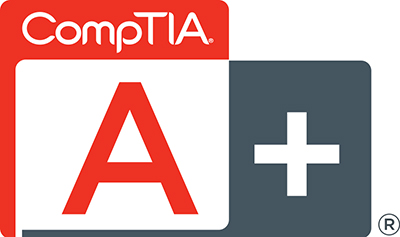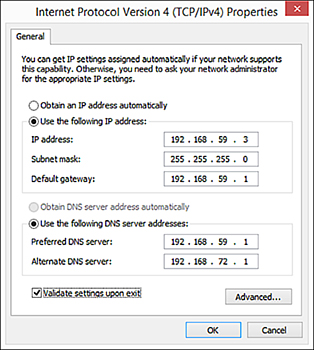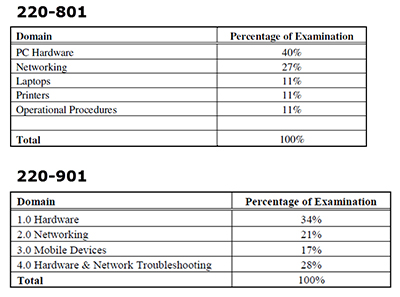CompTIA released a new version of its A+ computer repair certification (see Figure 1) on December 15, 2015. Whether you're currently preparing to pass the old 220-801 test or you're considering the new 220-901 version, you probably want to know what's new and what's changed in the exam. Let me help you with that!

Figure 1 The CompTIA A+ logo is displayed on all approved courseware.
What's Stayed the Same
Let's begin by considering what hasn't changed between the 220-801 and 220-901 tests. First of all, you still need to pass two exams to earn your A+ credential. Here's the breakdown:
- The 220-801/901 exam is colloquially called the "hardware" exam because its objectives deal primarily with computer hardware identification and troubleshooting.
- The 220-802/902 exam is affectionately referred to as the "software" exam because its content centers on operating system support.
In this article, we'll cover the hardware exam, and Part 2 of this series will discuss the 220-902 software test.
You'll find generous A+ exam details on CompTIA's A+ website, so I'll just give you a quick-and-dirty "punch list" here of some of the main points:
- The A+ certification expires after three years. But CompTIA gives certification recipients many ways to renew their credentials.
- You register for your A+ exams through Pearson VUE. CompTIA has an exclusive relationship with Pearson VUE; you can't register for CompTIA tests with Prometric.
- The A+ exams include performance-based items. In addition to the traditional multiple-choice items, you can expect to see interactive items that require you to perform a given configuration or troubleshooting task in a simulated environment. For example, you may be required to configure a Windows 8.1 computer with a static IPv6 address, as shown in Figure 2.

Figure 2 The CompTIA A+ exams include performance-based items.
801 Versus 901: High-Level Differences
You can (and should) download the CompTIA A+ 220-801 and 220-901 objective blueprints and study them thoroughly. Figure 3 compares the objective domains from the two exam versions.

Figure 3 Comparing the old and new A+ hardware exams.
One aspect that stands out immediately is that CompTIA has reduced the number of content domains from five to four. The exam still has big sections for hardware and networking, but the 901 exam adds a new domain for mobile devices and includes a separate troubleshooting domain. In previous A+ versions, troubleshooting theory and practice appeared only in the software test objectives.
Here's what I identify as the high-level trends in the 220-901 certification exam blueprint:
- The coverage of computer hardware is now much broader, taking into account laptops and mobile devices such as phablets, tablets, and smartphones.
- CompTIA made a concerted effort to remove references to antiquated technology; you won't see content related to SDRAM, CRT displays, floppy drives, PCMCIA cards, or IDE interfaces.
- Computer hardware is framed in a 21st-century context; in other words, the objectives deal not only with on-premises equipment but also virtualized and cloud-based systems and services.
- Printing as a subject is interwoven more uniformly across both new A+ exams. For instance, you need to understand how to manage printing from mobile devices as well as how to deploy Internet-based printing.
I'm really pleased with how CompTIA has updated these exams. As an A+ certified professional since 1999, I've seen the tests evolve over time. In my experience, the CompTIA A+ exams held on to legacy hardware and software for much too long. Kudos for not forcing us to memorize IRQ IDs anymore!
Next, let's spend a bit of time looking at the details of each 220-901 content domain.
Domain 1.0: Hardware
The change in name from "PC Hardware" to "Hardware" should raise some red flags for you. Sure enough, you'll need to go beyond desktop computer motherboards and hardware components to embrace laptops, sub-notebooks, ultrabooks, phablets, tablets, and smartphones.
The main emphasis remains on full-sized computers, but CompTIA realizes that many of its A+ candidates will work in "Bring Your Own Device" (BYOD) environments that require them to perform warranty repair on mobile devices.
This domain also sneaks in the printing process and printer components. A+ veterans already know that the laser printing process has been a long-standing A+ objective, and that's still true. However, don't forget about other types of printers, including thermal, inkjet, and dot matrix (yes, they're still around).
In keeping with contemporary computer-hardware trends, you'll see lots of UEFI firmware coverage, and not so much of the legacy BIOS. Old bus architectures like AGP have also (blissfully) gone the way of the dodo.
Domain 2.0: Networking
CompTIA no longer requires certification candidates to know the IPv4 address classes and traditional network topologies. After all, CompTIA offers the Network+ credential for entry-level network specialists. I think CompTIA now wants A+ professionals to focus not on the network as a whole, but rather on the "care and feeding" of individual networked devices.
The new exam also dispenses with older, unpopular protocols such as WiMAX and adds coverage of current standards like the IEEE 802.11ac Wi-Fi protocol. You'll also need to understand and apply the latest-and-greatest Ethernet cable standards such as Category 6e and 7a in real-world network support situations.
Domain 3.0: Mobile Devices
The Mobile Devices domain is brand new in the 901 exam and contains the bulk of the new content. To earn your A+ certification, you'll need to become a power user of mobile devices running the following operating systems:
- Apple iOS
- Google Android
- Windows Phone
I'll have more to say on mobile operating systems when we cover the 220-902 exam in Part 2 of this series. For the 901 exam, you'll need to identify a blistering array of mobile hardware, including but not limited to the following devices:
- Tablets, phablets, and smartphones
- Wearable tech (smart watches, fitness bands)
- Home and vehicle automation devices (smart cameras, GPS)
You'll also need to know how mobile devices interact with their owners as well as with other hardware; namely, the use of Bluetooth, infrared, and IEEE 802.11 Wi-Fi, with and without tethering.
Domain 4.0: Hardware & Network Troubleshooting
As mentioned earlier, CompTIA finally recognized that its six-step troubleshooting model should be part of both the hardware and software exams. This is a big domain, with a lot to understand. Your starting point is understanding the CompTIA troubleshooting model itself, but you'll also be required to apply those steps in the context of computer- and network-related problems.
CompTIA added a bunch of command-line utilities to the exam objectives. You need to get up to speed with working from the command line, not only in Windows, but in Linux and Apple OS X. (For instance, do you use ipconfig or ifconfig to view the TCP/IP configuration of a Windows-based computer? How about an iMac?)
Next Steps
The 220-801 exam retires on June 30, 2016 for the English test and on December 31, 2016 for all other languages. My advice: If you're at least 50% prepared for the 800-series exams, go ahead and certify with the old objectives. Both the 800 and 900 A+ versions expire after three years, and I seriously doubt that any IT hiring manager will ask, "Do you have the 800- or 900-series A+ certification?"
On the other hand, if you're just beginning your A+ certification preparation, I suggest that you focus on the 900-series tests to ensure that your technology knowledge is current.

